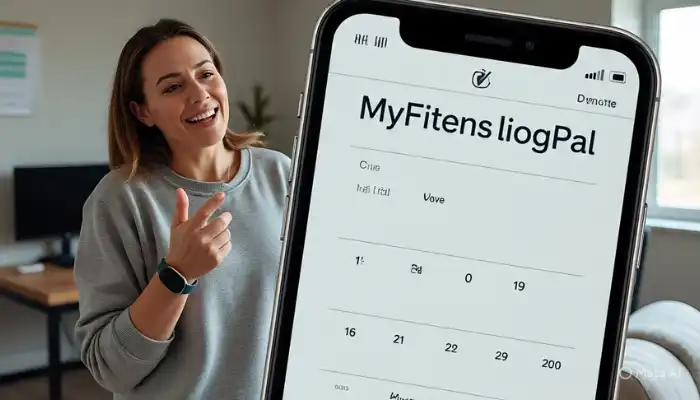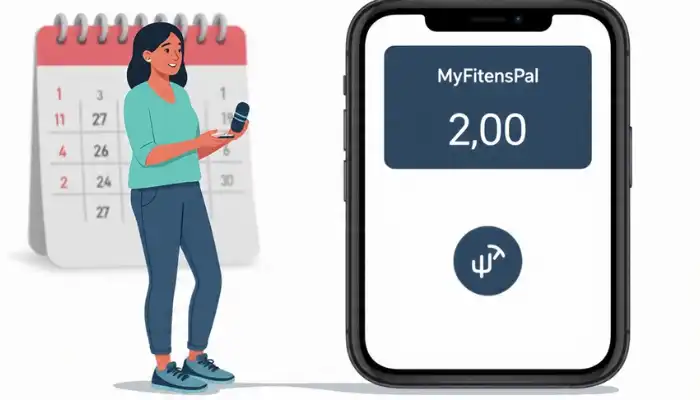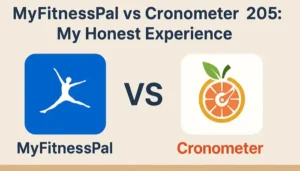By Sophie Lane
Hi everyone! I’m Sophie, and I’ve been using MyFitnessPal for over 2,000 days straight. That’s almost six years of tracking my food every single day! One of the coolest features I’ve discovered is voice logging – it’s like having a personal assistant that writes down everything you eat.
When I first heard about MyFitnessPal voice logging, I was skeptical. Could I really just talk to my phone and have it automatically add food to my diary? The answer is yes, and it’s been a game-changer for my daily routine!
Today, I want to share everything I know about using voice logging in MyFitnessPal. If you’re tired of typing every single food item or struggling with the tiny phone keyboard, this feature might change your life like it changed mine.

What Is MyFitnessPal Voice Logging?
Voice logging in MyFitnessPal is exactly what it sounds like – you can speak your food entries instead of typing them. It’s like talking to a smart friend who remembers everything you ate and automatically adds it to your food diary.
Here’s how simple it is: instead of typing “1 cup of oatmeal with banana,” you just say it out loud, and MyFitnessPal does the rest. The app uses speech recognition technology to understand what you’re saying and convert it into food entries.
Why Voice Logging Is Amazing
After using this feature for months, here’s why I love MyFitnessPal voice logging:
- Much faster than typing on a small phone screen
- Perfect for busy moments when your hands are full
- Great while cooking – no need to wash hands to use your phone
- Helps when driving (hands-free logging)
- Easier for people with typing difficulties
How to Set Up Voice Logging in MyFitnessPal
Getting started with voice logging is super easy. Here’s exactly how I set it up:
Step-by-Step Setup Process
- Open your MyFitnessPal app
- Make sure you have the latest version – voice features need recent updates
- Go to your food diary (the main logging screen)
- Look for the microphone icon near the search bar
- Tap the microphone to start voice logging
- Allow microphone permissions when your phone asks
Requirements for Voice Logging
| Requirement | Why It’s Needed | How to Check |
|---|---|---|
| Updated app | Voice features in newer versions | Check app store for updates |
| Microphone permissions | App needs to hear you | Settings > Privacy > Microphone |
| Good internet connection | Voice processing happens online | Test with other voice apps |
| Quiet environment | Better speech recognition | Find a quiet spot to speak |

How to Use Voice Logging: My Daily Process
Let me walk you through exactly how I use MyFitnessPal voice logging every day:
Basic Voice Logging Steps
- Open MyFitnessPal and go to your food diary
- Tap the microphone icon
- Wait for the “listening” indicator to appear
- Speak clearly and say your food item
- Wait for the app to process your speech
- Review the results and confirm or edit
- Save to your diary
What to Say for Best Results
The key to successful voice logging is knowing how to speak to the app. Here are my proven techniques:
Good Examples:
- “One cup of brown rice”
- “Six ounces grilled chicken breast”
- “Two tablespoons peanut butter”
- “One medium apple”
- “Half cup Greek yogurt”
What to Avoid:
- Speaking too fast or mumbling
- Using unclear measurements (“a bunch of” or “some”)
- Background noise or music
- Talking while eating (mouth full)
Voice Commands That Actually Work
Through lots of practice, I’ve learned which voice commands work best with MyFitnessPal:
Quantity Commands
- “One,” “Two,” “Three” – for whole numbers
- “Half,” “Quarter,” “Three-quarters” – for fractions
- “Cup,” “Tablespoon,” “Teaspoon” – for measurements
- “Ounces,” “Grams,” “Pounds” – for weights
Food Description Commands
- “Grilled chicken breast” – specific cooking method
- “Medium banana” – size descriptions
- “Whole wheat bread” – type specifications
- “Fat-free milk” – nutritional variations
Meal Timing Commands
- “For breakfast” – assigns to specific meal
- “For lunch” – meal categorization
- “For dinner” – evening meal logging
- “For snack” – between-meal items
Troubleshooting Common Voice Logging Problems
Even after months of using voice logging, I still run into problems sometimes. Here’s how I solve them:
Problem #1: App Doesn’t Recognize My Voice
Possible Causes:
- Speaking too quietly or loudly
- Background noise interference
- Phone microphone blocked
- Poor internet connection
My Solutions:
- Speak at normal conversation volume
- Find a quiet room
- Check for phone case blocking microphone
- Switch to better WiFi or cellular signal
Problem #2: Wrong Food Gets Added
Common Mix-ups I’ve Experienced:
- “Rice” becomes “ice”
- “Chicken” becomes “kitchen”
- “Banana” becomes “bandana”
How I Fix This:
- Speak more slowly and clearly
- Use specific brand names when possible
- Review entries before saving
- Edit incorrect entries manually
Problem #3: Measurements Get Confused
Examples of Confusion:
- “One cup” heard as “won cup”
- “Two tablespoons” becomes “to tablespoons”
- “Half ounce” turns into “have ounce”
My Prevention Tips:
- Pause between numbers and measurements
- Say “one-half” instead of “half”
- Spell out “tablespoon” fully
Advanced Voice Logging Techniques
After mastering the basics, I’ve discovered some advanced voice logging tricks:
Logging Multiple Foods at Once
You can actually log several foods in one voice command:
Example: “One cup oatmeal, one banana, and two tablespoons almond butter for breakfast”
The app will try to separate these into individual entries. Sometimes it works perfectly, sometimes you need to edit afterward.
Using Brand Names
Brand-specific logging often works better than generic terms:
| Generic Voice Command | Brand-Specific Command | Why Brand Works Better |
|---|---|---|
| “Protein bar” | “Quest protein bar chocolate” | More specific database match |
| “Cereal” | “Cheerios General Mills” | Exact nutrition information |
| “Yogurt” | “Chobani Greek yogurt vanilla” | Precise serving size |
Voice Logging Recipes
For homemade foods, I’ve learned to be very specific:
Good Example: “Homemade chicken salad with mayo, celery, and grapes, one cup”
Better Example: “My chicken salad recipe, serving number two”
The second version works if you’ve already created a custom recipe in MyFitnessPal.
When Voice Logging Works Best vs. When to Type
After extensive use, I’ve figured out when voice logging is most helpful:
Best Times for Voice Logging:
- While cooking – hands are busy or messy
- During meal prep – logging ingredients as you add them
- In the car – hands-free logging after eating out
- When multitasking – folding laundry, walking, etc.
- For simple, whole foods – apple, banana, chicken breast
When Typing Is Better:
- Complex recipes with many ingredients
- Foods with unusual names – ethnic dishes, special brands
- Very quiet environments – library, church, meetings
- When accuracy is critical – precise macro tracking
- Multiple similar items – easier to copy/paste
Voice Logging Tips That Actually Work
Here are my top tips for successful MyFitnessPal voice logging based on real experience:
Environmental Tips:
- Find a quiet space – even low background music can interfere
- Hold phone 6-8 inches from your mouth – not too close, not too far
- Speak at normal volume – no need to whisper or shout
- Face the phone’s microphone – usually at the bottom of the device
Speaking Tips:
- Talk like you’re ordering at a restaurant – clear and specific
- Pause between different foods – gives the app time to process
- Use common measurement terms – stick to cups, tablespoons, ounces
- Repeat if necessary – the app will let you try again
Technical Tips:
- Close other apps that might use the microphone
- Keep MyFitnessPal updated – voice features improve with updates
- Test your microphone with other voice apps first
- Have good internet – voice processing requires data connection
Comparing Voice Logging to Other Input Methods
Let me break down how voice logging compares to other ways of adding food to MyFitnessPal:
| Input Method | Speed | Accuracy | Best For | Difficulty |
|---|---|---|---|---|
| Voice logging | Very fast | Good with practice | Simple foods | Easy |
| Barcode scanning | Super fast | Very high | Packaged foods | Very easy |
| Manual typing | Slow | Depends on you | All foods | Medium |
| Recent foods | Fastest | High | Foods you eat often | Very easy |
My Personal Ranking:
- Barcode scanning – for packaged foods
- Voice logging – for whole foods and cooking
- Recent foods – for repeated meals
- Manual typing – for complex or unusual items
Real-World Examples from My Daily Routine
Let me share some actual examples of how I use voice logging throughout my day:
Morning Coffee Setup:
What I say: “Two tablespoons heavy cream and one teaspoon sugar for coffee”
What happens: MyFitnessPal adds both items to my breakfast log
Why it works: I’m making coffee with my hands busy, voice is perfect
Cooking Dinner:
What I say: “Six ounces salmon fillet, grilled”
While cooking: Hands are handling raw fish, can’t touch phone
Result: Food logged without interrupting cooking flow
Snack Time:
What I say: “One medium apple with two tablespoons almond butter”
Why voice helps: Eating while working, typing would be inconvenient
Accuracy: Usually gets this combination right
The Future of Voice Logging in MyFitnessPal
Based on my experience and industry trends, I think voice logging will get even better:
Improvements I Expect:
- Better recognition of food names and measurements
- Multiple language support for international foods
- Integration with smart speakers – Alexa, Google Home
- Offline voice processing – no internet required
- Meal context understanding – knowing it’s breakfast time
Features I Hope For:
- Recipe voice input – describe entire recipes by speaking
- Nutrition question answers – “How many calories in my lunch?”
- Voice-activated meal planning – plan tomorrow’s meals by speaking
- Integration with cooking apps – voice logging while following recipes
Final Thoughts: Is Voice Logging Worth It?
After using MyFitnessPal voice logging for months, here’s my honest assessment:
What I Love:
- Saves significant time during busy cooking sessions
- Makes logging feel more natural and conversational
- Perfect for hands-free situations
- Reduces typing errors on small phone screens
- More likely to log foods immediately instead of forgetting
What Could Be Better:
- Still requires review and editing for accuracy
- Doesn’t work well in noisy environments
- Can struggle with unusual food names
- Needs good internet connection
- Not always faster than barcode scanning
My Recommendation:
Voice logging isn’t perfect, but it’s a valuable addition to your MyFitnessPal toolkit. I use it about 30% of the time now, especially when:
- My hands are busy or dirty
- I’m cooking and want to log ingredients immediately
- I’m eating simple, whole foods
- I’m multitasking and can’t stop to type
The key is knowing when to use voice and when to use other input methods. It’s not meant to replace all other logging methods, but it makes certain situations much easier.
If you haven’t tried MyFitnessPal voice logging yet, I encourage you to give it a shot. Start with simple foods you eat regularly, practice in quiet environments, and be patient as you learn what works best.
Remember, the best food tracking method is the one you’ll actually use consistently. If voice logging makes you more likely to track your food accurately, then it’s absolutely worth learning!
Sophie Lane has been using MyFitnessPal for over 2,000 consecutive days and has extensively tested voice logging features since their introduction. She enjoys exploring health technology innovations and sharing practical tips for successful nutrition tracking. When not testing app features, Sophie loves cooking healthy meals and experimenting with meal prep techniques.


